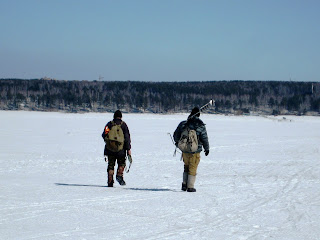Last Sunday, the weather finally gave hint of the summer approaching. We decided to go for a walk on the frozen lake and see if the fishing season was good.  As you can see on the picture, the level of water has dropped significantly, which should be a good omen for the fishermen (less water means a higher density of fish, any fisherman knows that). Uh, and the other thing is that there is still a decent 4-ft layer of ice on the lake, which is another good news for my friends the fishermen who still have a few nice days in their ice-fishing season.
As you can see on the picture, the level of water has dropped significantly, which should be a good omen for the fishermen (less water means a higher density of fish, any fisherman knows that). Uh, and the other thing is that there is still a decent 4-ft layer of ice on the lake, which is another good news for my friends the fishermen who still have a few nice days in their ice-fishing season.
 As you can see on the picture, the level of water has dropped significantly, which should be a good omen for the fishermen (less water means a higher density of fish, any fisherman knows that). Uh, and the other thing is that there is still a decent 4-ft layer of ice on the lake, which is another good news for my friends the fishermen who still have a few nice days in their ice-fishing season.
As you can see on the picture, the level of water has dropped significantly, which should be a good omen for the fishermen (less water means a higher density of fish, any fisherman knows that). Uh, and the other thing is that there is still a decent 4-ft layer of ice on the lake, which is another good news for my friends the fishermen who still have a few nice days in their ice-fishing season.We met a few fishermen carrying their drills, walking large distances to find their good spots.

-How to recognize fishermen on the way to fishing versus fishermen on the way back? Not so easy: the amount of fish they carry can be misleading, as these guys like to snack on salted fish while they fish for more... (Ice-fishing is a sustainable activity). The trick is in the way they walk: A good fisherman always walk straight to his fishing spot. Most fishermen have vodka-induced staggering walk on the way back.
-How to use bait fish with worms frozen hard by subzero temperatures?Simply put the worms in a plastic bag with no hole, and suck on the plastic bag not too hard until you feel that the worm softens up.
-How to recognize a good spot for ice-fishing? Not so easy either, there appears to be different strategies prevailing on the Ob Sea:
-How to use bait fish with worms frozen hard by subzero temperatures?Simply put the worms in a plastic bag with no hole, and suck on the plastic bag not too hard until you feel that the worm softens up.
-How to recognize a good spot for ice-fishing? Not so easy either, there appears to be different strategies prevailing on the Ob Sea:
-the first strategy is to look for spots where there already are other fishermen.

-the second strategy consists in looking for spots where there are no fisherman. It is radically different from the first approach, but the logic is also solid: No competing fisherman means more fish for you, so you should go and drill there.
 Between these 2 extreme strategies, a wide range of intermediate solutions also work, i.e chosing spots where there are only a few fishermen proving that it is a good spot for fish, but not enough people to catch all the fish, so you can also go and drill there.In brief, the main criterion for a good spot is to make sure that there is water on the other side of the ice where you are drilling.
Between these 2 extreme strategies, a wide range of intermediate solutions also work, i.e chosing spots where there are only a few fishermen proving that it is a good spot for fish, but not enough people to catch all the fish, so you can also go and drill there.In brief, the main criterion for a good spot is to make sure that there is water on the other side of the ice where you are drilling. Well, in the end, the one who enjoyed the walk the most was still Urmik. He was quite impervious to fishing strategies and just enjoys running aimlessly on the ice. Good doggie.




3 comments:
Ah- after a long break (over a month between posts) I'm happy to see such a detailed, and informative piece. One item that wasn't properly covered was the health of the fish. If I remember correctly, the fish in the summer have parasites and swim on their sides near the surface (likely due to buoyancy problems). Do these fish die because they are pressed up against the ice sheet in the winter? Do any self conscious fishermen simply scoop up these floating fish and put them on their line so they don't look bad next to their comrades? Your public eagerly waits your next installment
Thank you for the sound advice. I will print this off and keep it in my wallet in case the lakes here freeze over and I need to catch some fish because Central Market is closed
I don't understand a word on this blog! It's 38C here (~100F) and ther's no such thing as fresh water (solid or liquid) and who wants to feed on fishes anyway (you should have a look at the sea in Kuwait... makes you feel a bit suspicious about fishes). Man... t's to leave... (not for Kuwait though).
Post a Comment